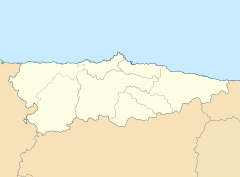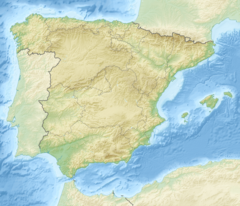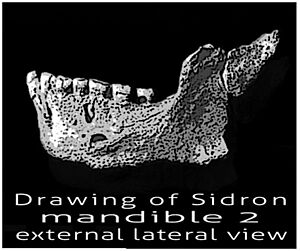Sidrón Cave facts for kids
|
Cueva del Sidrón
|
|
| Location | Piloña municipality |
|---|---|
| Region | Asturias |
| Coordinates | 43°23′10″N 5°19′42″W / 43.38611°N 5.32833°W |
| Type | karst |
| History | |
| Periods | Paleolithic |
| Associated with | Neanderthals |
| Site notes | |
| Public access | no |
The Sidrón Cave (Asturian: Cueva del Sidrón) is a large natural cave system in northwestern Spain. It is located in the Piloña area of Asturias. This cave is famous because it contains ancient Paleolithic rock art. Even more exciting, scientists found the fossils of more than a dozen Neanderthals here!
The cave is also a special home for five types of bats. In 1995, it was made a "Partial Natural Reserve" to protect its unique features. Scientists have even discovered two new types of beetles inside the cave.
Contents
About the Cave
This huge cave system is about 3,700 meters (12,139 feet) long. It has a very large main area that is 200 meters (656 feet) long. The most important part is called the Ossuary Gallery. This is where the Neanderthal fossils were found. This gallery is about 28 meters (92 feet) long and 12 meters (39 feet) wide.
In 1994, some human bones were found by accident in the cave. At first, people thought they were from the Spanish Civil War. This was because soldiers sometimes hid in caves. But later tests showed that the bones were much older. They belonged to Neanderthals!
The Tunnel of Bones
The most interesting part of Sidrón Cave is the Ossuary Gallery. It is also known as the Tunnel of Bones (Galería del Osario). This is where many Neanderthal remains were discovered. Scientists dug in this area from 2000 to 2013. All the Neanderthal bones came from one specific layer of earth, called Stratum III.
Along with the bones, scientists found 53 stone tools. There were not many animal bones, but some red deer bones were present. A few small mammals and snails were also found.
Neanderthal Discoveries
Researchers found over 2,500 pieces of human-like fossils in the cave. These pieces belonged to at least 13 different Neanderthals. The group included three men, three teenage boys, four women, and three babies. Scientists believe these Neanderthals lived about 49,000 years ago.
The bones are very well preserved. They show very little damage and no bite marks from large animals. The way the bones were found, mixed in with gravel and mud, suggests something unusual happened. It seems these Neanderthals did not die inside the cave. Instead, they likely died somewhere else. Then, their bodies ended up in this small, room-sized space.
Scientists have a few ideas about how they got there. It could have been from a flood or a cave-in. Another idea is that they were put there by other humans. Some evidence, like cut marks on the bones, suggests they might have been eaten by other humans. It is also possible they fell into the cave through cracks above the site. This could have happened during a big storm.
Neanderthal Body Features
The Neanderthals from El Sidrón show many features typical of Neanderthals. However, some of their traits are a bit different from other Neanderthals. When scientists compare the jawbones from El Sidrón with other Neanderthal jawbones, they see a pattern. Neanderthals from the southern parts of Europe had wider faces. They also had taller lower faces. The Sidrón Cave is in the northern part of Europe.
How Neanderthals Grew
Scientists studied a well-preserved young Neanderthal from the Tunnel of Bones. This young Neanderthal is called El Sidrón J1. Studying this fossil helped researchers learn how Neanderthals grew and developed. By looking at its teeth, scientists think El Sidrón J1 was between 7 and 8 years old when it died.
About 36% of this young Neanderthal's body was found. This included important parts of its head, teeth, and spine. In total, 138 fossil pieces were found, including 30 teeth and a full jawbone. Based on how strong its bones were, scientists think El Sidrón J1 was likely a male.
El Sidrón J1 shows signs of growing up more slowly than modern humans. When it died, its brain was probably not fully grown. Its brain size was about 1,330 cubic centimeters. This is about 87% of an average adult Neanderthal's brain size. For comparison, a modern human child of the same age usually has about 95% of an adult human's brain size. Also, a bone in its spine had not yet joined together. In modern humans, this usually happens about two years earlier.
Some other scientists, like Marcia Ponce de León and Christoph Zollikofer, have said to be careful when interpreting the brain size. They say there are not enough cases to be sure. Tanya Smith also noted that the idea depends on how accurate the tooth's age is.
Ancient DNA Studies
Scientists have studied the ancient DNA (genetic material) from three Neanderthals found in El Sidrón cave. They looked at a part of the DNA passed down from mothers (called mtDNA). Researchers also studied parts of the DNA from the main genome (passed down from both parents).
Two of the Neanderthals from Sidrón Cave had the same changes in a gene called FOXP2. This gene is often called the "language gene." These changes are also found in humans today.
In 2017, scientists were able to get Neanderthal DNA from soil samples in the cave. This showed that the DNA belonged to more than one Neanderthal.
Neanderthal Y Chromosome
For the first time, scientists successfully sequenced the Y chromosome of a Neanderthal. This was done using a sample from Sidrón Cave. The Y chromosome is passed down from fathers. Based on this, scientists think Neanderthals and modern humans separated from a common ancestor about 590,000 years ago. The Y chromosome found in Sidrón Cave had never been seen in other ancient human fossils. It is also not found in modern humans. The Sidrón Cave Y chromosome had some differences in genes compared to modern humans.
Neanderthal Diet
Recent studies of the Neanderthal remains from El Sidrón have shown what they ate. Their diet mainly included pine nuts, moss, and mushrooms. This is different from what scientists found at other sites in Europe. At those sites, Neanderthals seemed to eat more meat.
See also
 In Spanish: Cueva de El Sidrón para niños
In Spanish: Cueva de El Sidrón para niños
- List of fossil sites
- Atapuerca Mountains
- Sima de las Palomas





